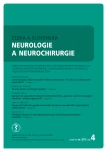Intraoperative Monitoring of Anorectal Sphincter Complex during a Surgery in Children with Anorectal Malformations
Authors:
V. Mixa 1; J. Kraus 2; R. Škába 3; K. Cvachovec 1
Authors‘ workplace:
2. LF UK a FN v Motole, Praha
Klinika anesteziologie, resuscitace a intenzivní medicíny
1; 2. LF UK a FN v Motole, Praha
Klinika dětské neurologie
2; 2. LF UK a FN v Motole, Praha
Klinika dětské chirurgie
3
Published in:
Cesk Slov Neurol N 2012; 75/108(4): 468-471
Category:
Short Communication
Overview
Diagnostic perioperative electromyostimulation of the sphincter complex muscles with bipolar Pena stimulator is used for anorectal reconstruction in children with congenital anorectal malformations (ARM). The objective of this study was to develop an accurate technique for perioperative measurement of electromyographic parameters in children with ARM and, consequently, to determine the most suitable method of general anesthesia. A KeyPoint EMG v3.22 (Medtronic) was used. The tissue of the sphincter complex was stimulated with a bipolar electrode and a DCN 25 thin concentric needle electrode was used for recording. Intensity of the stimulation was 14 mA administered over 0.2 ms. The method was used in 17 patients repeatedly during a surgery for anorectal malformation. The examinations were performed at various stages of anesthesia: after induction and during epidural blockade or after administration of a muscle relaxant. The results were compared to scarce data in the literature and confirmed their validity. Through evaluation of the results, the described method was found to be sufficiently accurate. A combination of inhalation anesthesia, opioids and epidural block, with an exclusion of non-depolarizing muscle relaxants, was determined to be the most useful method of anesthesia.
Key words:
perioperative electromyostimulation – anorectal malformation – anorectal sphincter complex – caudal epidural anesthesia
Sources
1. Peña A. Surgical management of anorectal malformations: a unified concept. Pediatr Surg Int 1988; 3 : 82–93.
2. Peña A. Posterior sagittal anorectoplasty: results in the management of 332 cases of anorectal malformations. Pediatr Surg Int 1988; 3 : 94–104.
3. Peña A, Grasshoff S, Lewitt M. Reoperations in anorectal malformations. J Pediatr Surg 2007; 42(2): 318–325.
4. Škába R, Rousková B. Současný stav léčení anorektálních malformací. Rozhl Chir 1997; 76(8): 389–393.
5. Lefaucheur JP. Neurophysiological testing in anorectal disorders. Muscle Nerve 2006; 33(3): 324–333.
6. Podnar S, Rodi Z, Lukanovic, Trsinar B, Vodusek DB. Standardization of anal sphincter EMG: Technique of needle examinaton. Muscle Nerve 1999; 22(3): 400–403.
7. Vodusek DB, Janko M, Lokar J. Direct and reflex responses in perineal muscles on electrical stimulation. J Neurol Neurosurg Psychiat 1983; 46(1): 67–71.
8. Chantraine A, DeLeval J, Onkelinx A. Motor conduction velocity in the internal pudendal nerves. In: Desmedt JE (ed). New Developments in Electromyography and Clinical Neurophysiology, Basel: Karger 1973 : 433–438.
9. Jelasic F, Fischer D, Allert ML. Diagnosis of neurologic disorders of micturition without evidence of the pathological process by measuring conduction velocity of sacral roots. Urol Int 1975; 30(1):
100–102.
10. Tørring J, Pedersen E, Klemar B, Schrøder HD. Anal sphincter responses after peri-anal electrical stimulation. Proc XI Ann Meeting Internat Continence Soc, Stockholm, Sweden, 1981 : 150–151.
11. Pedersen E, Klemar B, Schroder HD, Torring J. Anal sphincter responses after perianal electrical stimulation. J Neurol Neurosurg Psychiatry 1982; 45(9): 770 –773.
12. Trontelj JV, Janko M, Godec C, Rakovec S, Trontelj M. Electrical stimulation for urinary incontinence. Urol Inter 1974; 29(3): 213–220.
Labels
Paediatric neurology Neurosurgery NeurologyArticle was published in
Czech and Slovak Neurology and Neurosurgery

2012 Issue 4
- Advances in the Treatment of Myasthenia Gravis on the Horizon
- Metamizole vs. Tramadol in Postoperative Analgesia
- Hope Awakens with Early Diagnosis of Parkinson's Disease Based on Skin Odor
Most read in this issue
- Cerebral Arachnoid Cysts in Adults – Retrospective Analysis of the Results of Surgical Treatment
- Rhythmic Movement Disorder
- Isolated Sphenoid Sinusitis – Possible Cause of Headache and Severe Complications
- The Oswestry Questionnaire, Version 2.1a – Results in Patients with Lumbar Spinal Stenosis, Comparison with the Previous Version of the Questionnaire
